A REFLECTION
A trip to Tibet: Whose country is it anyway?
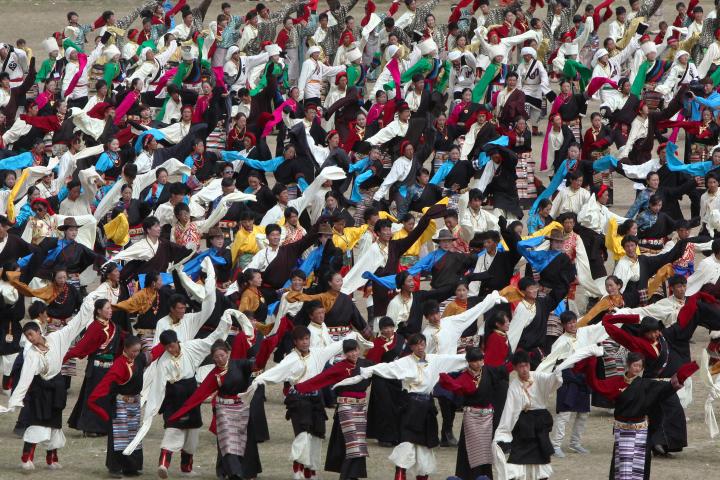
China has been trying for decades to convince the world that it is the true custodian – and liberator – of a magical, spiritual land high in the Himalaya mountains. The government recently took a group of South African opinion-makers to Tibet to show them what it’s been doing there since its army invaded in 1951.
“Seeing is believing,” China’s ambassador to South Africa Lin Songtian said before we left for Tibet. His idea was that the visit would dispel the Western-propagated, anti-Chinese myths about this controversial – what to call it, country? – for many Tibetans. For the Chinese government, it is the “Tibet Autonomous Region” (TAR) of China.
There is much to see and marvel at in Tibet, though believing is inevitably a little more complicated. Certainly, it’s easy to see why Tibetans love their country and why some (who knows how many?) would like it to be just Tibet.
The majestic backdrop of the soaring misty snow-capped peaks of the Himalayas and its foothills, disgorging countless churning rivers and streams to rush through grassy uplands dotted with shaggy yaks to the distant sea, the monumental Potala Palace and the Jokhang Temple with its golden roofs in Lhasa … all these and more give this place its unique character as “The Roof of the World” – in the words of tourist brochures.
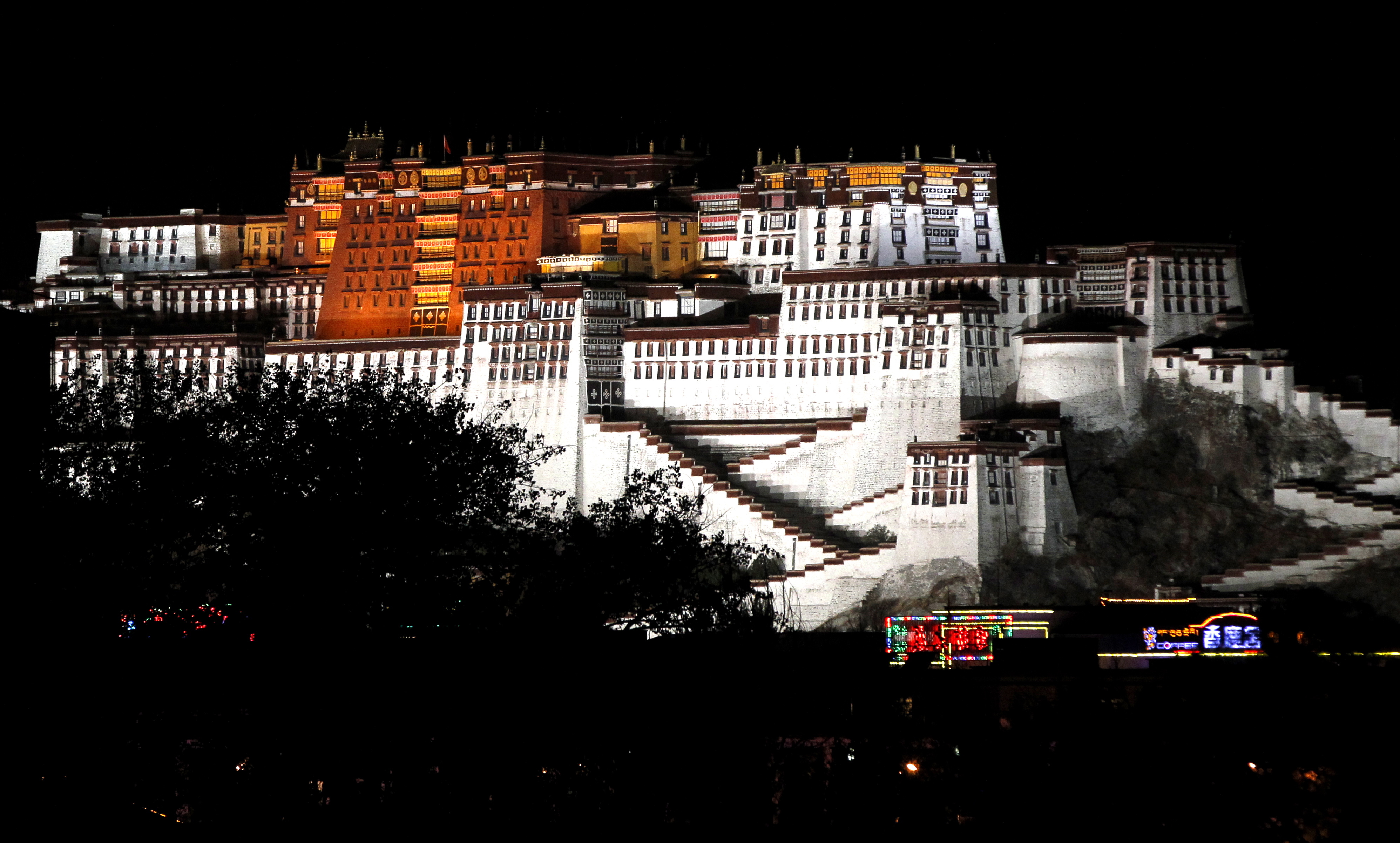
The night lit Potala Palace as it towers over the city of Lhasa, one of the highest cities in the world and the capital of the Tibet Autonomous Region, the People’s Republic of China, 18 October 2011. TEPA/BARBARA WALTON
The South African journalists and academics on this trip can attest to the loftiness of Tibet. Lhasa perches at 3,600 metres (twice as high as Johannesburg) in the Himalayan foothills. One day we climbed to 5,200 metres (just shy of the summit of Kilimanjaro, for comparative purposes) to reach the shimmering iridescent blue lake of Namtso. Our hosts considerately provided a large cylinder of oxygen in our bus at all times so we could gulp high-octane air when altitude sickness threatened.
There were also oxygen canisters in our hotel rooms in the aptly named Shangri-La Hotel, which also boasted an “oxygen lounge” where one could breathe oxygenated air.
Like their landscape, the Tibetan people are quite distinct, ethnically and culturally, with their own language; their own, often fervent, brand of Buddhism; their physical appearance, with a coppery-bronze skin colour; and their unique clothing and customs.
Does this distinct identity not justify the demand for self-determination – or at least a greater measure of it – by the Dalai Lama and his government-in-exile in India, I asked at the China Tibetology Research Center in Beijing.
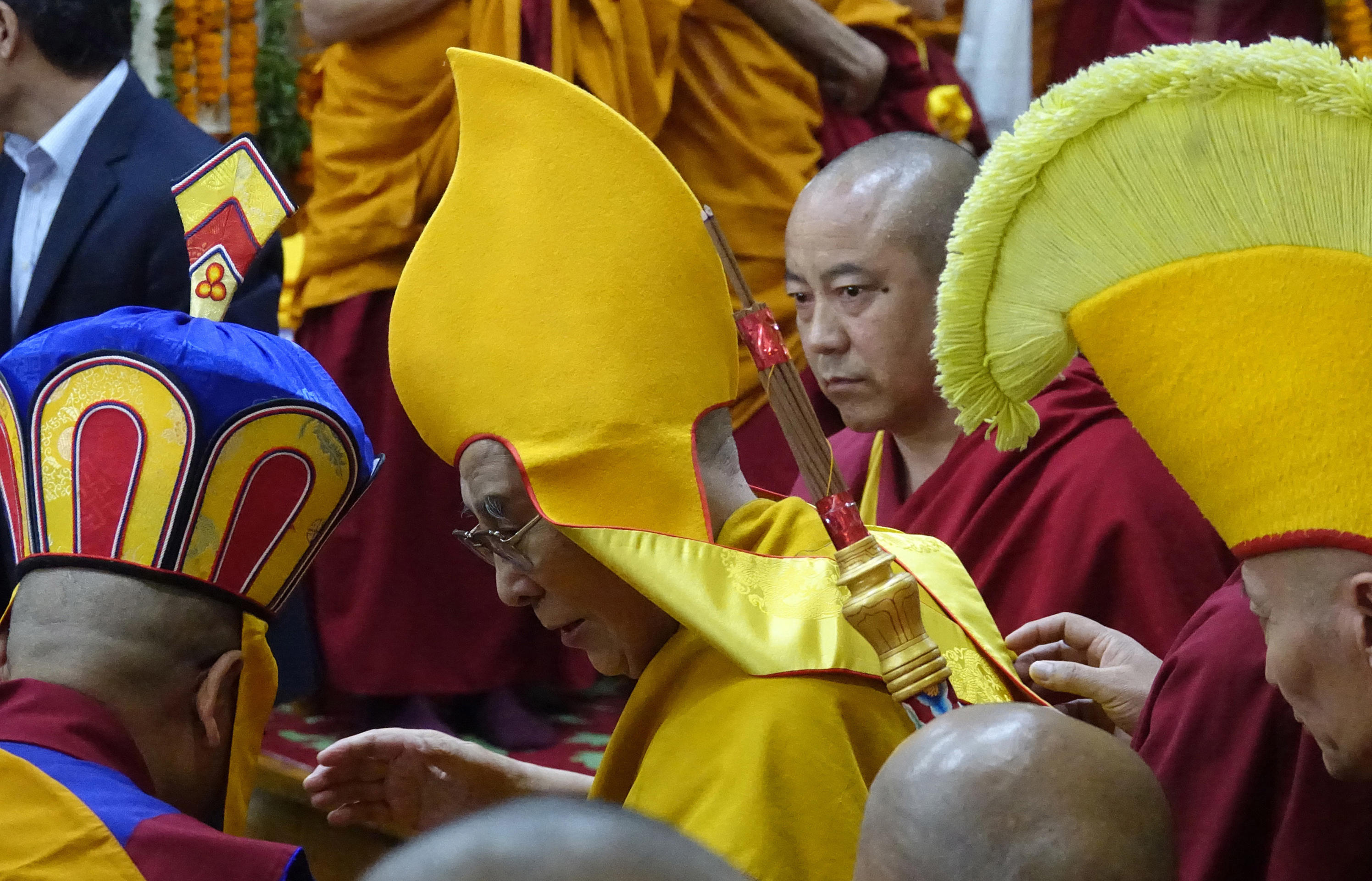
Tibetan spiritual leader Dalai Lama (C) attends a Long Life offering prayer, at the main Buddhist temple of Tsuglagkhang, near the town of Dharamsala, India, 17 May 2019. EPA-EFE/SANJAY BAID
Yao Maochen, curator of the museum of Tibetan culture at the centre, acknowledged that, according to original Marxist doctrine, different ethnic groups do have to the right to seek independence and said the Communist Party of China (CPC) explored this possibility before it came to power in 1949.
“But, for the country and society, stability comes first,” Yao added. “On the one hand we have to respect the identity of ethnic groups. But, on the other hand, we have to maintain national stability because only with national stability can peace, happiness and development become possible.”
To discuss ethnic independence theoretically was meaningless, he said, without putting it in the context of not only of China’s national stability but also its national law – which makes splitting up the country illegal. Independence for any part of China would also be contrary to the will of the majority of the Chinese as it would violate the Chinese tradition of different ethnic groups working together against foreign aggression and coexisting “like the seeds of a pomegranate”.
According to Sam van Schaik in his “Tibet; A History”, Mao Zedong himself argued in the 1930s that Tibetan, Mongol and Muslim minorities should be allowed independence, but by the 1940s his view had hardened to offering them just autonomy within China. Van Schaik thought Mao came to believe China would be much safer defending its southwestern flank behind the towering Himalayas than it would be doing so on the exposed banks of the Yangzi and other rivers.
These arguments, however, put China’s interests before Tibet’s, one might counter. What about the Tibetans? China does have one big argument for why it was also in the interest of Tibet’s people that China entered Tibet in 1951 and began a process of “peaceful democratic reform”.
It says it did so to emancipate most Tibetan people from serfdom under what it calls the feudal theocracy of the 14thDalai Lama (the same man the world now knows simply as “the Dalai Lama”, though he is the latest in a long line of Dalai Lamas who governed Tibet with lesser or greater success from 1543 – until he fled into exile in 1959).
The Exhibition Hall on the Emancipation of Tibet from Serfdom in Lhasa’s Tibet Museum of Natural Science tells horrific illustrated stories of atrocities allegedly conducted by the feudal masters – the landlords, senior government officials and high lamas (or religious leaders) – against the serfs. These include photographs of manacled and shackled people sweating in the fields, living in animal pens and “suffering savage punishments, including cutting off hands or feet and even peeling off skins”.
The photographs show instruments that were allegedly “used to gouge out eyes of the serfs”’, along with a “scorpion cave to torture serfs”.
The museum avers that 5% of the ruling class owned 95% of the wealth of the society.
The exhibition suffers from inattention to chronological detail. For instance, our guide was unable to say when the photographs were taken. Were conditions still so atrocious when China entered in 1951 or had they improved by then?
What is not in dispute is that Tibet was a feudal society under the Dalai Lamas (and before them), with most citizens bonded to landlords and unable to sell their labour on an open market; i.e. virtual slaves.
The Chinese did indeed emancipate the population, seizing the land of theocrats and handing it to workers. Several senior officials we met proudly told us “my father was a serf”.
“The serfs are now masters of their own destiny” was a slogan we heard from many officials.
The government in Beijing has also brought broader development to Tibet, including several new towns, 90,000kms of roads, several new railways – including extending the mainline from Beijing to reach Lhasa – five modern airports, an electricity power grid that reaches 2.19 million people or 70% of the population. And so on. The scale of infrastructural development is typically Chinese: monumental.
Ambassador Lin is particularly proud of the fact that the national government has made a special effort to elevate much of the road and railway networks to allow animals such as yak and Tibetan antelope, to move freely beneath them across their ranges.
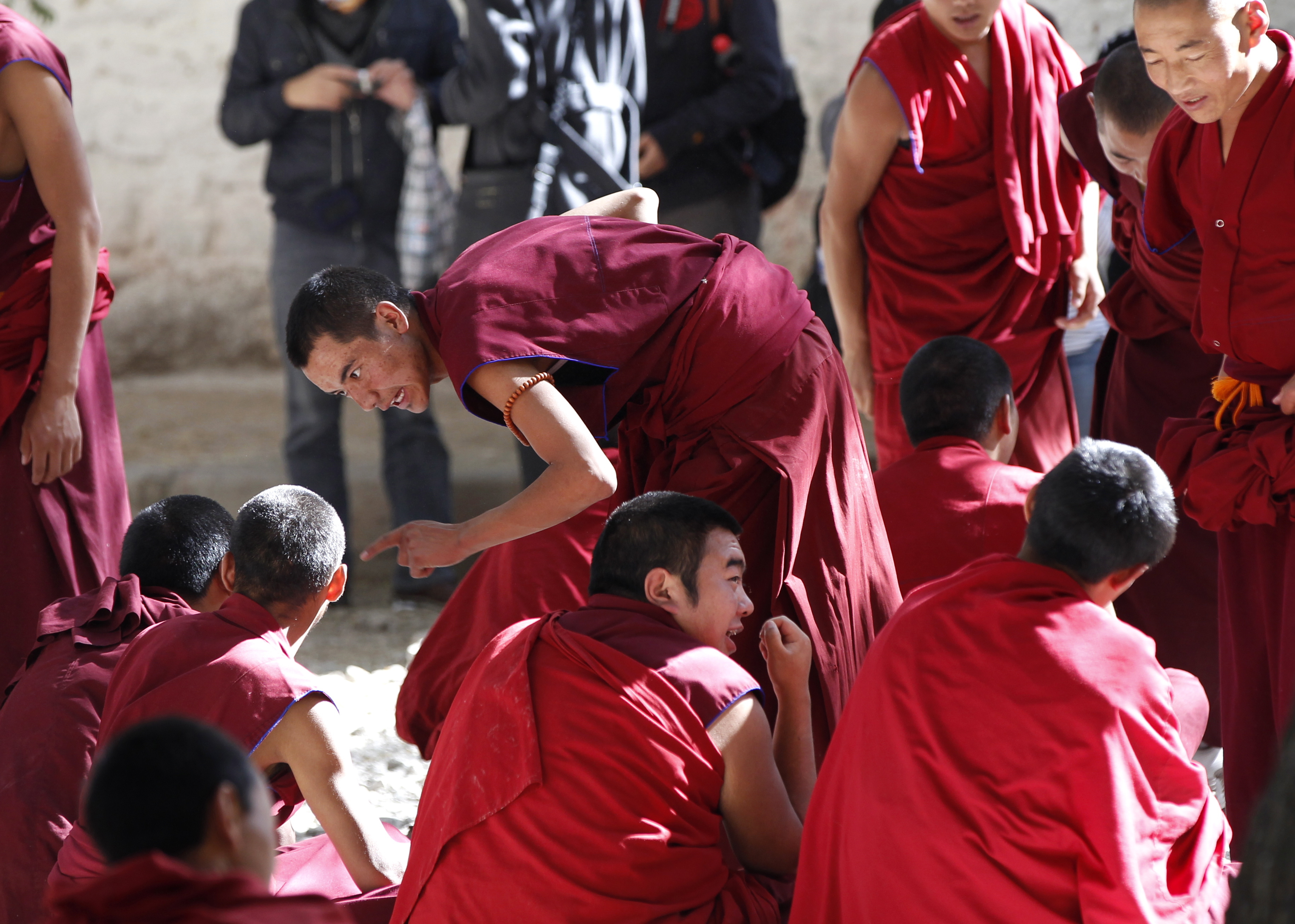
Tibetan Buddhist monks debate Buddhism in the courtyard of the Sera monastery in Lhasa, one of the highest cities in the world and the capital of the Tibet Autonomous Region, the People’s Republic of China, 18 October 2011. EPA/BARBARA WALTON
Beijing and the government of the Tibet Autonomous Region have also focussed on education, raising primary school enrolment to 99.64% and decreasing illiteracy from 95% in the early 1950s to less than 0.57% today, according to government statistics.
Nine years of compulsory education are provided in all counties and 15 years of free education in agricultural and pastoral areas and to the disadvantaged.
Officials like to say life expectancy has doubled under Chinese rule, from 35.5 years in 59 to 70.6 today. Medical treatment is cheap for all and free for the needy.
Tibet’s gross domestic products was 147,76 yuan (or RMB) last year, which, in a population of some 3.4 million and with a current exchange rate of about seven yuan to the US dollar, gives a GDP per capita per annum of about $6,154.
Wang Daiyuan, Head & Research Fellow, Institute of Economic Studies of the Academy of Social Science in Lhasa, described this as being “just under” China’s overall GDP per capita.
Most statistics put the latter at about $9,770, so Tibet has some way to go. Wang’s explanation is that Tibet is still catching up after a slow start and, helped by Beijing’s emphasis on developing its outlying areas, its GDP is growing faster than that of any other region and it will match the national average in a two to three years.
His colleague Duoqing, head of the academy’s Institute of Rural Economic Studies, notes that the number of Tibetans still living in poverty has been brought down from 850,000 a few years ago to 150,000.
The government intends to reduce that number to zero by the end of this year, through its targeted poverty alleviation strategy. “Targeted”, as he underscores, means the authorities have to know the reasons for the poverty of each of those 150,000 people.
The strategy includes industrial development (though avoiding damage to the pristine environment); resettlement of farmers in more fertile areas; better education, including scholarships; ecological stewardship – in the form of government-paid jobs to take care of grasslands and rivers; providing for the basic needs of elderly; and skills training.
We saw varied examples of Beijing’s developmental interventions, including a free home in Lhasa for elderly people who have no family to care for them; a yak-meat agro-business where the hydroponic growth of barley feed for the animals is controlled remotely from Beijing, and a barley-beer brewery where the young entrepreneur gets 100,000 yuan a year from the central government to train college graduates to run pubs he is establishing to sell his product.
But if Beijing has brought impressive general development to Tibet, has it also preserved and nurtured the unique Tibetan culture? This includes the Buddhist religion, which arrived there 1,400 years ago and was inextricably intertwined with its politics – until the Peoples’ Republic moved in in 1951?
During the early years, peaking with Mao’s disastrous Great Leap Forward and Cultural Revolution in the late 1950s and early 1960s, many monasteries and Buddhist artefacts were destroyed in the orgy of iconoclastic pillaging that ravaged China, Van Schaik notes.
China came to realise that to compete with the Dalai Lama on the world stage, and in Tibet itself, it had to re-invent itself as a custodian of Tibetan culture, including Buddhism.
Now it boasts of spending large amounts of money on preserving and maintaining Tibetan cultural relics – including more than two billion yuan from 2001 to 2015, with another 1,8 billion-plus earmarked for 2016 to 2020.
It says it has allocated funds and gold and silver to maintain and protect some of Tibet’s fabulous temples and monasteries such as Potala Palace, Jokhang Temple, the ornate former Dalai Lama’s summer residence Norbulingka and the equally historic Sakya monastery.
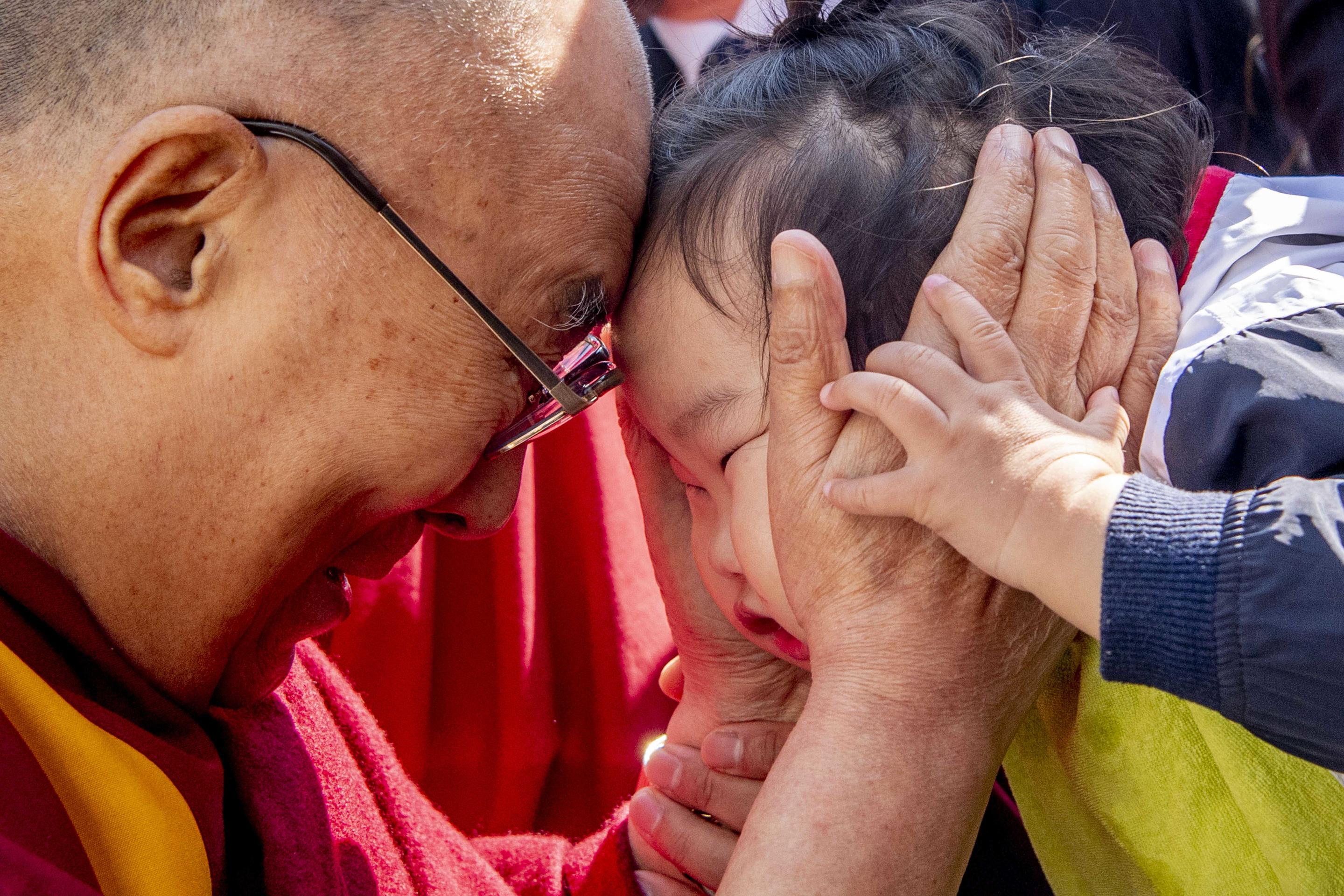
Tiibetan spiritual leader Dalai Lama greets a child as he meets with supporters after his arrival at the Bilderberg Parkhotel in Rotterdam, The Netherlands, 14 September 2018, EPA-EFE/ROBIN UTRECHT
More than 40 million yuan has gone on a 20-year project to revise and publish the ancient Tibetan Buddhist canons, Kangyur and Tengyur.
Critics complain that China is in reality “Sinofying” Tibet. They point out that, despite notable achievements in education, teaching in the Tibet language does not continue until the end of schooling, so pupils must go to the Chinese mainland to complete their education.
It is also claimed that China is diluting Tibetan ethnicity by bringing in large numbers of settlers from the ethnic Han group, which is dominant in China.
Zhang Yun, director of the Institute of Tibetan History Studies at the China Tibetology Research Center, denies the latter charge, insisting that 3.13 million (or 92%) of the total 3.43 million population of the Tibet Autonomous Region’s remains ethnic Tibetan. Han number only 30,000, with other ethnic minorities making up the rest. He says the ethnic ratio has remained largely unchanged since the 1950s.
Deciding who owns, or ought to own, a particular territory is usually a fraught exercise. China’s assertion is that Tibet has been part of China since the Yuan dynasty conquered Tibet in 1290. But Van Shaik points out that the “Yuan dynasty” is more accurately described as a Mongol invasion of both China and Tibet under Kubilai Khan and that when the Ming dynasty overthrew the Mongols – in China itself – in 1368, the Chinese regarded this as a return to Chinese rule.
It is true that in 1720 the Manchu dynasty entered Tibet with a force comprising Manchus, Chinese, Tibetan and Mongol troops to oust the brutal Junghar Mongol faction. Ironically, their purpose was to restore the seventh Dalai Lama to his throne.
The Manchus maintained a presence in Tibet for decades after that, but ruled, if that is the word, mostly by proxy through Tibetan proconsuls. So, the relationship between Tibet and China has always been hard to define.
How would Tibet have fared if the Chinese had stayed out in 1951 and the Dalai Lama had remained in charge? He was just 16 when the People’s Liberation Army crossed the border, having been enthroned aged five in 1940. Photographs show an understandably bewildered looking boy on the throne of power.
China now portrays him as a grasping politician, not the spiritual leader portrayed by him and the West. It’s true that Dalai Lamas have always been political as well as religious leaders. The “Great Fifth” Dalai Lama, as he is called, was not above enlisting Mongol warriors to slaughter adherents of rival Buddhist sects and put him in charge in the 17thcentury.
Van Schaik paints the current Dalai Lama as a moderate figure who, despite his tender years, in 1951 felt that Marxism was closer to his Buddhist humanitarian ideals than was traditional Tibetan society.
He and then-moderate Mao got on well at first, trying to reform Tibet, before a combination of Mao’s sudden about-turn into the excesses of the Great Leap Forward and violent resistance to land reform by some Tibetan monks and other landowners sparked an uprising that forced the Dalai Lama to flee to India.
Now, aged 84, he is reportedly very ill. The Dalai Lama succession is a complex and mystical process, involving a search for the young boy who is believed to have received the reincarnated soul of the previous incumbent.
The names of a few likely candidates are inscribed in ivory, placed in a golden urn and drawn at random to identify the new Dalai Lama. But this choice, many of our official interlocutors insisted, has to be approved by Beijing.
The message seemed to be that Beijing will have the final say in choosing the 15thDalai Lama. How that will go down in Lhasa, is hard to say. DM
Peter Fabricius travelled to Tibet with a group of South African journalists and academics as a guest of the Chinese government

















 Become an Insider
Become an Insider